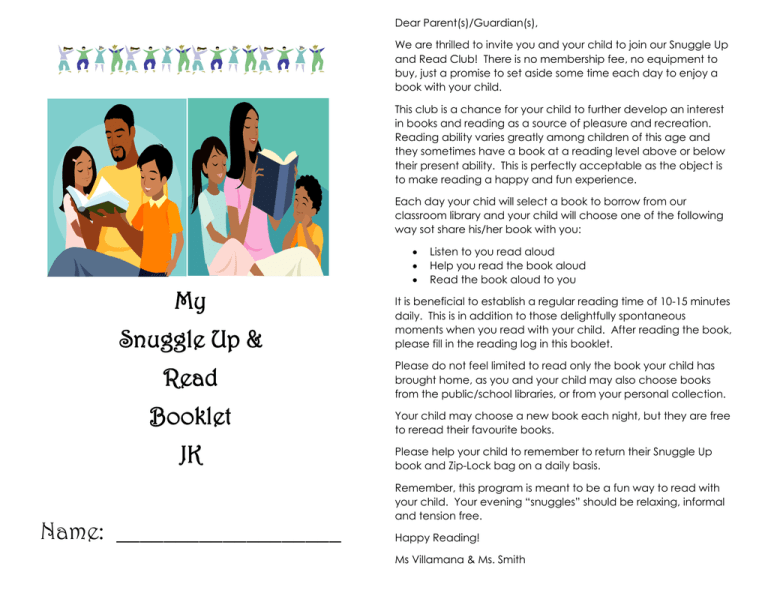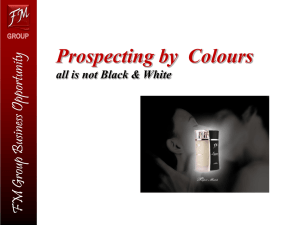Document 14427626
advertisement

Dear Parent(s)/Guardian(s), We are thrilled to invite you and your child to join our Snuggle Up and Read Club! There is no membership fee, no equipment to buy, just a promise to set aside some time each day to enjoy a book with your child. This club is a chance for your child to further develop an interest in books and reading as a source of pleasure and recreation. Reading ability varies greatly among children of this age and they sometimes have a book at a reading level above or below their present ability. This is perfectly acceptable as the object is to make reading a happy and fun experience. Each day your chid will select a book to borrow from our classroom library and your child will choose one of the following way sot share his/her book with you: My Snuggle Up & Read Booklet JK Name: ___________________ Listen to you read aloud Help you read the book aloud Read the book aloud to you It is beneficial to establish a regular reading time of 10-15 minutes daily. This is in addition to those delightfully spontaneous moments when you read with your child. After reading the book, please fill in the reading log in this booklet. Please do not feel limited to read only the book your child has brought home, as you and your child may also choose books from the public/school libraries, or from your personal collection. Your child may choose a new book each night, but they are free to reread their favourite books. Please help your child to remember to return their Snuggle Up book and Zip-Lock bag on a daily basis. Remember, this program is meant to be a fun way to read with your child. Your evening “snuggles” should be relaxing, informal and tension free. Happy Reading! Ms Villamana & Ms. Smith Tips for Reading Aloud to Your Child: Hold the book so that both of you can easily see. Point to each word as you read. Make reading fun – use different expressions and voices. Stop when your child indicates that he/she has had enough. Read and re-read your child’s favourites. Read all kinds of materials – stories, poems, magazines, non-fiction texts, notes, etc. Include books that have predictable/repetitive language patterns that your child can pick up on and repeat easily. Enjoy the time together! Tips For Sharing the Reading With Your Child Together, the 2 of your hold the book. Point to each word together. Echo read (You point and read a sentence and then your child repeats). Take turns or try to read together. As you read, let your child take over and chime in on repetitive/predictable parts. When solving unknown words, encourage your child to look at the picture, look at the letters (especially the initial letter for beginners) and think about what would make sense. Enjoy the time together! Tips When Your Child is Reading to You If your child gets stuck on a word, prompt him/her to: o Look at the picture to help predict the word o Try using the beginning letter(s)/sound(s) o Look to see if there are parts of the word that he/she knows (eg. cat in the word catch.) Don’t let your chid get frustrated by spending a long time trying to figure out a word. If he has tried unsuccessfully, tell him the word. If the book is too hard for your child, read it together and ENJOY it. Praise your child’s reading efforts. Enjoy the time together! Developing Concepts About Print You may select one or two items to point out and discuss with your child. These are not mandatory activities, but suggestion to help deepen your child’s understanding of books and reading. Hand the book to your child and have him/her show you the right way up, and the front and back of the book. Point to and read the title. Open the book and show how books are read from front to back. Explain that a word is made up of letters and there are spaces between words. Ask your child to point to where you should start reading. Read the book, pointing to the words in order to show that a book is read from left to right, top to bottom. Demonstrate how the pages are turned. Discuss how the pictures help the reader make sense of the story, and help the reader make predictions about the story. Discuss how letters and numbers are different. Discuss how letters have 2 forms – capital (uppercase) and lowercase. Talk about what a period/question/exclamation mark mean. Conduct a word hunt and find a High Frequency Word Demonstrate how you can “hug” a word using 2 fingers to bracket a word. Ask your child to: o “Hug” 1 word on the page. o “Hug” the first or last letter of a word of your choice. o “Hug” a word starting with __ (letter/sound of your choice). o “Hug” a word that starts with a capital/lower case letter. Talking About Books November Talking about books is just as important as reading them! Before your start, read the title and looks at the cover and wonder what the story will be about (i.e. predict). Talk about the characters, setting, problem and solution. Encourage your child to ask questions and make comments (express his/her opinions) before, during and after reading. Ask your child to describe their favourite part of the story and why. High Frequency Words The following words are some of the most common words in the English language. Please practice these words with your child. It is important that all students learn to recognize these words instantly and to spell them correctly also. the he at if of was be by and for this not to on have an a are from what as can where is see said you his an that they go look come she or I here it use in with my shouted For each book that you read this month, colour in one fallen leaf. What colour are the leaves that fall off the tree in autumn? December For each book you read this month colour in an ornament on the Christmas tree. Don’t forget to colour the tree too! January For each book you read this month in a snowflake. Remember every snowflake looks different. February March For each book you read this month, colour in a Valentine’s Day heart! Write the name of someone special inside each heart. For each book you read this month, colour in a clover. Can you spot the lucky 4 leaf clover? April For each book you read this month, colour in a rain drop falling from the clouds. Remember, April showers bring May flowers! May For each book you read this month, colour a flower. Make them as colourful as you want! June For each book you read this month, colour is a balloon. Celebrate all the wonderful reading you did this year!





